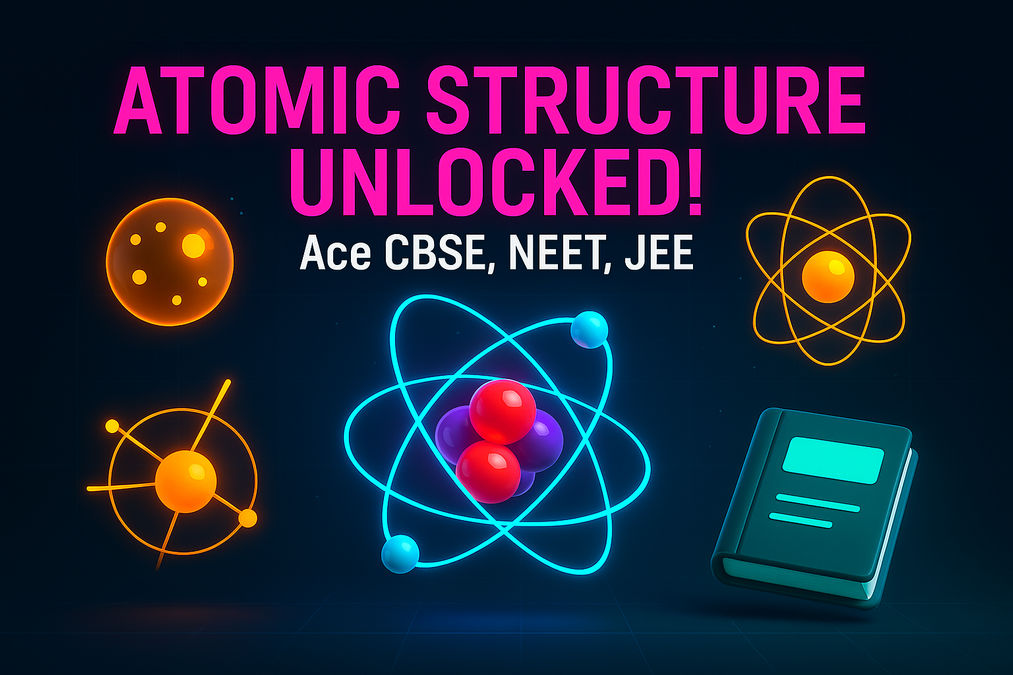Mastering Atomic Structure for Exams

By Rajesh Jaipal | The Govt Guide
Introduction to Atomic Structure
Atomic structure is the cornerstone of chemistry and physics, explaining how matter is built from the tiniest particles. Whether you’re prepping for CBSE, NEET, or JEE, understanding atoms is key to acing your exams. This vibrant guide uses colorful thought boxes to break down complex concepts like sub-atomic particles, atomic models, and valency into bite-sized, easy-to-digest insights. Let’s embark on this colorful journey into the world of atoms!
Atoms are the building blocks of everything around us—your phone, your food, even you! Understanding their structure unlocks the secrets of chemical reactions and material properties.
What is Atomic Structure?
Atomic structure refers to how sub-atomic particles—protons, electrons, and neutrons—are arranged within an atom. These particles define an element’s identity and behavior. By the late 19th century, scientists debunked Dalton’s idea of indivisible atoms, revealing that atoms contain smaller, charged particles.
Sub-Atomic Particles
Atoms are made of three key particles, each with unique properties:
- ⚡️ Electrons: Negatively charged, nearly massless, discovered by J.J. Thomson in 1897.
- 🔴 Protons: Positively charged, with a mass 2000 times that of an electron, found via Goldstein’s canal rays in 1886.
- 🟣 Neutrons: Neutral, with a mass similar to protons, discovered by J. Chadwick in 1932.
Protons and neutrons are called nucleons because they reside in the atom’s nucleus, while electrons zip around it in orbits!
Evolution of Atomic Models
Scientists developed models to explain how sub-atomic particles are organized. Let’s explore these models with colorful insights:
Thomson’s Plum Pudding Model
J.J. Thomson imagined the atom as a “plum pudding,” with electrons (negative charges) embedded in a positively charged sphere. This model explained the atom’s neutrality but failed to account for experimental observations.
Picture a watermelon: the red flesh is the positive charge, and the seeds are electrons scattered throughout!
Rutherford’s Nuclear Model
Ernest Rutherford’s alpha-particle scattering experiment revealed that:
- 🌟 Most alpha particles passed through a gold foil, showing atoms are mostly empty space.
- 🌟 Some particles deflected, indicating a small, dense, positively charged nucleus.
- 🌟 A few rebounded, confirming the nucleus’s concentrated mass.
Rutherford’s model proposed a tiny nucleus with protons, orbited by electrons, but couldn’t explain why electrons didn’t collapse into the nucleus.
Rutherford compared the rebounding particles to firing a shell at tissue paper and it bouncing back—mind-blowing!
Bohr’s Model of the Atom
Neils Bohr refined Rutherford’s model, proposing that electrons orbit the nucleus in fixed energy levels (K, L, M shells) without losing energy. This explained atomic stability and electron distribution.
Bohr’s model is like planets orbiting the sun, but with fixed paths that keep electrons stable!
Electron Distribution and Valency
Electrons occupy shells based on the Bohr-Bury scheme:
- 🔹 Maximum electrons per shell: 2n² (e.g., K-shell = 2, L-shell = 8).
- 🔹 Outermost shell holds up to 8 electrons.
- 🔹 Inner shells fill before outer ones.
Valence electrons in the outermost shell determine valency, the atom’s ability to bond. For example:
- 🔵 Carbon: 4 valence electrons, valency = 4.
- 🔵 Sodium: 1 valence electron, valency = 1.
Think of valency as an atom’s “handshake” power—how many hands (electrons) it can share or give to bond with others!
Atomic Number and Mass Number
The atomic number (Z) is the number of protons, defining the element. The mass number (A) is the sum of protons and neutrons. For example:
- 🟠 Oxygen: Z = 8, A = 16 (8 protons + 8 neutrons).
Isotopes, like hydrogen’s protium (¹H) and deuterium (²H), have the same Z but different A due to varying neutrons.
Isotopes are like siblings—same parents (protons), but different weights (neutrons)!
Conclusion
Atomic structure is a fascinating topic that reveals the inner workings of matter. From Thomson’s plum pudding to Rutherford’s nucleus and Bohr’s orbits, each model paints a clearer picture of atoms. With thought boxes to guide you, understanding sub-atomic particles, electron distribution, and valency becomes engaging and fun. Master these concepts to excel in your science exams!
Call to Action
Ready to ace your science exams? Explore more vibrant guides at The Govt Guide and subscribe for colorful study tips!
FAQs
1. What is atomic structure?
Atomic structure is the arrangement of protons, neutrons, and electrons within an atom.
2. Who discovered the electron?
J.J. Thomson discovered the electron in 1897 through cathode ray experiments.
3. What are canal rays?
Canal rays are positively charged radiations, discovered by E. Goldstein, that led to the proton’s identification.
4. What was Thomson’s model of the atom?
Thomson’s model likened the atom to a plum pudding, with electrons embedded in a positive sphere.
5. What did Rutherford’s experiment show?
Rutherford’s experiment revealed a dense, positively charged nucleus with electrons orbiting it.
6. How does Bohr’s model differ?
Bohr’s model places electrons in fixed energy levels, preventing energy loss and ensuring stability.
7. What is valency?
Valency is an atom’s ability to bond by gaining, losing, or sharing electrons to achieve a stable octet.
8. How is atomic number defined?
Atomic number (Z) is the number of protons in an atom’s nucleus, defining the element.
9. What are isotopes?
Isotopes are atoms of the same element with the same atomic number but different mass numbers.
10. What are isobars?
Isobars are atoms of different elements with the same mass number but different atomic numbers.
11. How are electrons distributed in shells?
Electrons fill shells based on the 2n² rule, with a maximum of 8 in the outermost shell.
12. What is the mass number?
Mass number (A) is the sum of protons and neutrons in an atom’s nucleus.
13. Why was Thomson’s model limited?
Thomson’s model couldn’t explain the results of Rutherford’s alpha-particle scattering experiment.
14. What are the applications of isotopes?
Isotopes are used in nuclear reactors, cancer treatment, and medical applications like goitre treatment.
15. Who discovered neutrons?
J. Chadwick discovered neutrons in 1932, identifying them as neutral particles in the nucleus.
Join the conversation